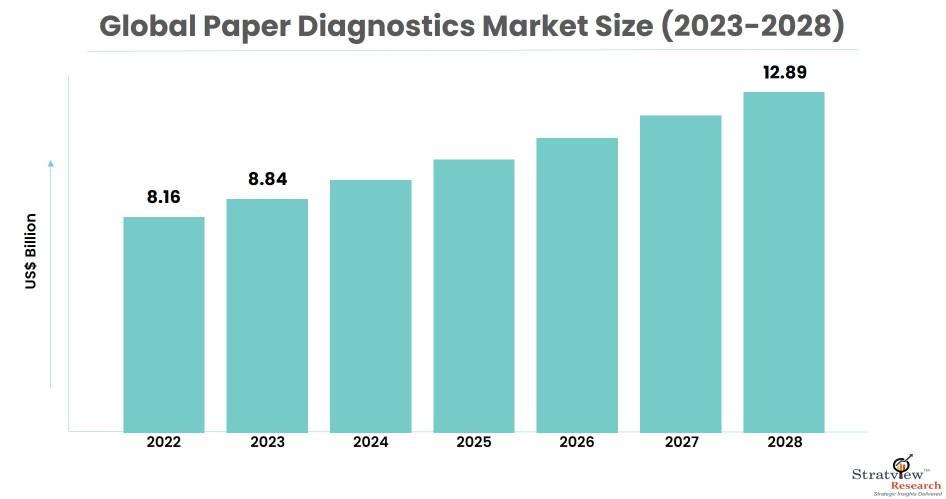The healthcare industry is undergoing a metamorphosis, driven by a growing emphasis on point-of-care (POC) testing, accessibility, and affordability. In this evolving landscape, paper diagnostics, also known as lateral flow assays (LFAs), are emerging as a game-changer. These user-friendly and rapid tests offer a compelling alternative to conventional laboratory diagnostics, particularly in resource-limited settings. As a result, the paper diagnostics market is experiencing significant growth, presenting a wealth of exciting investment opportunities.
Market Overview
According to Stratview Research, the global paper diagnostics market size was valued at USD 8.16 billion in 2022 and it is expected to reach USD 12.89 billion by 2028, growing at a CAGR of 7.83% during the forecast period of 2023-2028.
Decoding the Investment Potential: Why Paper Diagnostics are Booming
Paper diagnostics are essentially disposable devices built on a familiar platform – cellulose paper. Pre-loaded with specific capture and detection reagents, these tests are designed to identify target analytes (proteins, antibodies, or antigens) present in a biological sample like blood, saliva, or urine. When the sample is applied, it migrates through designated zones on the paper strip due to capillary action. If the target analyte is present, it interacts with the pre-immobilized reagents, triggering a visual signal (often a colored line) in a designated zone.
This ingenious design offers several compelling attributes, making paper diagnostics a lucrative investment proposition:
- Unmatched Simplicity: Paper-based tests require minimal training and infrastructure, making them ideal for use by both healthcare professionals and non-professionals. This opens doors to a wider market, including resource-limited settings.
- Speed is King: Compared to traditional laboratory testing, paper diagnostics deliver results within minutes. This expedited process facilitates faster diagnosis and treatment initiation, crucial for time-sensitive situations.
- Cost-Effectiveness is Key: Paper diagnostics are significantly cheaper to manufacture and administer compared to conventional laboratory tests. This affordability expands access to essential diagnostics, creating a larger market base, particularly in low- and middle-income settings.
- Portability: A Boon for On-Site Testing: Compact and lightweight, paper-based tests offer unparalleled portability. They require minimal storage space, making them ideal for field use and deployment in remote locations, broadening the market reach.
- Scalability and Multiplexing Potential: Paper diagnostics can be readily scaled for mass production, ensuring widespread availability. Additionally, advancements are enabling the development of multiplex assays that can detect multiple analytes simultaneously on a single paper strip, further enhancing their utility and market value.
A Spectrum of Applications: Driving Market Growth and Investment
The versatility of paper diagnostics extends to a wide range of applications, creating diverse investment opportunities across various healthcare domains:
- Combating Infectious Diseases: Paper diagnostics play a vital role in the rapid diagnosis of infectious diseases like HIV, malaria, dengue, influenza, and COVID-19. This empowers early intervention, improved patient outcomes, and better disease control efforts. The increasing global focus on pandemic preparedness creates significant investment potential in this segment.
- Chronic Disease Management: Paper-based tests are increasingly used for monitoring chronic conditions like diabetes, cardiovascular diseases, and allergies. They empower patients with self-testing capabilities, enabling better disease management and promoting preventative healthcare. This growing trend presents investment opportunities in chronic disease management tools and paper-based diagnostic kits.
- Food Safety and Environmental Monitoring: Rapid detection of contaminants in food and water samples is crucial for public health. Paper diagnostics offer rapid and cost-effective solutions for on-site food and environmental testing, safeguarding communities and promoting a healthier environment. This segment presents potential for investment in food safety and environmental monitoring solutions utilizing paper diagnostics.
- Drug Testing Made Easy: Paper-based tests are finding application in drug screening programs, offering a convenient and reliable method for detecting illicit substances. This has applications in workplace settings, addiction treatment programs, and law enforcement, creating an investment opportunity in workplace safety and drug screening solutions.
Technological Advancements: Fueling Innovation and Investment
The paper diagnostics market is not stagnant. Fueled by continuous research and development, a wave of technological advancements is propelling this market forward, creating new avenues for investment:
- Microfluidics: A Marriage of Convenience and Precision: Integrating microfluidic technology into paper diagnostics can enhance sensitivity, accuracy, and automation, leading to more robust and reliable tests. Investment in companies developing microfluidic-based paper diagnostics holds significant promise.
- Advanced Materials for Enhanced Performance: The development of novel materials with improved properties, such as enhanced biocompatibility and signal amplification capabilities, is further improving the performance of paper-based tests. Investment in companies pioneering advanced materials for paper diagnostics can be highly lucrative.
- Digital Integration: Expanding Diagnostic Reach: The coupling of paper diagnostics with digital technologies like smartphones and cloud platforms opens doors for remote data capture, analysis, and interpretation. Investing in companies developing digital platforms for paper diagnostics can be highly profitable.


